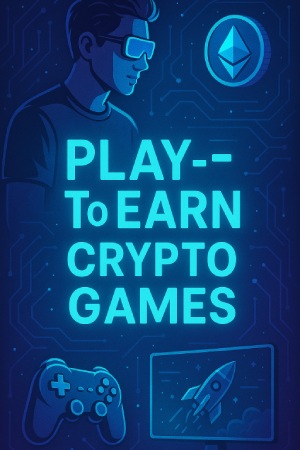How Do Play-to-Earn Games Work?
The three major components behind the working of a P2E game are: blockchain technology, in-game assets, and reward system. And these elements have to interact in the following way:

Blockchain Technology
The blockchain serves as the base for transparency and security in P2E games. It ensures players' ownership of various in-game assets, whether NFTs or tokens, with transactions being recorded immutably. So, if you are awarded an item like a rare sword or a piece of virtual property in the course of a game, ownership of that item is verified onto the blockchain level, booting it into your possession and allowing it to be sold or traded with other players.
In-Game Assets
In-game assets are what one receives in the game, often NFTs or tokens. These assets would be entirely different depending on the game. Some games allow the buying, selling, and trading of virtual real estate, while others focus on the more straightforward notion of collectible items such as characters, skins, or weapons. These assets can hold real-world value and are often priced according to their rarity.
The P2E industry is centered around Axie Infinity, one of the most popular platforms. It allows users to breed and battle creatures called Axies. Some of these creatures are rare and might fetch a handsome price due to their attributes and demand in the game's marketplace.
Reward Systems
Most P2E games map in their reward system to appreciate the player's activity. The reward can be in a form of tokens, NFTs, or any other kind of digital asset. Some even allow staking opportunities, wherein the player gets rewarded with extra tokens for maintaining their in-game asset for a specified locked period.
Play-to-Earn In-Game Value
Value in a P2E game refers to the worth of digital assets within the game. Its worth can be gauged in one or several methods:

Market Value
The value of items fluctuates based on supply and demand, just as would occur with any other asset. Because of game economies and player demand, the sale of a rare sword in a game may be anywhere from several hundred to several thousand dollars.
Utility
In-game assets can also offer utility by helping the player accomplish goals within the game. For example, certain rare characters or weapons might give some sort of advantage in battles, thus making them sought after by players aiming to get the best battle performance.
Tradeability
A huge in-game value driver in P2E games lies in the secondary market capacities of trading assets. One can sell his rare item for something else, or for cryptocurrency, which in turn can later be converted and cashed-out for legal tender. Such a linkage directly connects the game to the world economic sphere, which thereby adds to the allure of P2E games.
Differences Between Play-to-Earn & Traditional Video Games
Therefore, traditional video games vs. play-to-earn games even have similar gameplay elements, such as "missions," "leveling up," "multiplayer," etc., but P2E games work very differently from the conventional style:
A Price Tag on Play
Traditional video games have players spending money on loot box-type items such as skins, loot boxes, or any other cosmetic item, to be used within the game, in exchange for money. Therefore, such purchases do not come with any form of return or value outside the world of the game. On the flip side, play-to-earn games on the financial incentivization side allow players to trade or sell any assets for real-world money. Thereby, the players make real money by playing, which is hugely unlike the traditional mode of gaming.
Ownership of Assets
In conventional games, there is no ownership of the digital assets acquired, whether it is a skin, character, or weapon; rather, they are considered to be owned by the developer of the game. Players simply enjoy the use of these items for theirs could not be sold for any real value. On the contrary, P2E games give players genuine ownership of their in-game assets. The assets are kept on the blockchain, where players can prove ownership irrespective of whether the game itself shuts further down or changes. This is one of the main differences between traditional games and P2E games that is based on ownership from a decentralized point of view.
Long-Term Value
In any conventional video game, progress might sometimes get erased-the moment the game gets discontinued, or the player's account gets banned-with no room for rescue. But in P2E games, players can perhaps keep the value of their assets for some time. Items earned may be sold or transferred on another platform, even if the game falls out of favor or has its server shut down, opening long-term value for the player. These things do not happen in traditional gaming.
Play-to-Earn and Play-For-Fun
While P2E games certainly offer a great deal of fun, price is usually the primary focus for most players. By contrast, regular video games tend to place entertainment and enjoyment in the foreground, with little thought given to offering actual rewards in the form of real money. This additional nature of remuneration puts another layer of strategic interest in P2E games, as the players themselves might be looking to play the game as an investment, aiming to derive profit as much as they derive fun.
Summary
Play-to-earn crypto games are reshaping the gaming industry by giving an opportunity for players to earn rewards in real life via their in-game operations. Blockchain technology in these games manufactures absolute ownership of digital assets, which in turn can be traded, sold, or profited from. With the reward system developing through the chance to earn cryptocurrencies and NFTs, this destiny dwindles to manual payment for fun through raw hours. Depending on one's gaming prowess, P2E games form an entertaining and earning amalgam definite future for gaming.
Quick Links
Most Web3 games die alone...
— Nico (@MintOfTheDay) July 19, 2025
➝ @dropee_app games thrive together! 🔥
Shared token. Shared players. Shared momentum.
That’s how ecosystems scale 📈 pic.twitter.com/y4A2fDNiis